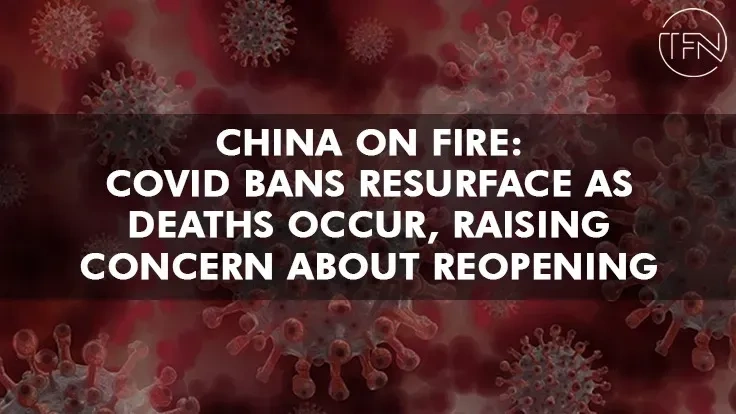
China's laxer COVID Zero policy has been in place for a week and is already encountering difficulties.
Local officials are at a loss on how to contain the spread of infection without the typical tools of large citywide testing and sudden lockdowns as diseases are threatening to overwhelm some of the biggest and most significant cities in the nation.
Three COVID deaths in the Chinese city of Beijing, the first in more than six months, gave the populace that had been protected from the disease by the strict approach a sobering reality check.
The virus is forcing China's leaders to make a life-or-death decision over whether to accept the increasing case count that eventually engulfed every other large nation or return to the tried-and-true control mechanisms that have strangled their economy.
Early signs point to a return to the harsh zero-tolerance policy in hard-hit areas as local officials get alarmed by the rising case counts, especially as winter approaches.
The issue is that local officials are being pushed to accomplish two opposing objectives with little direction on how to do so. In its most recent commentary, People's Daily, the premier publication of the official media, outlined the challenge, stating that China must stop using an excessive, one-size-fits-all strategy while also avoiding an imprudent exit.
That is an impossible task, according to Huang Yanzhong, a senior fellow for global health at the Council on Foreign Relations in New York. He claimed that local officials are growing more perplexed.
Huang stated, "They were quite aware in the past that they needed to get cases to zero." They are now in a predicament and unsure of what to do.
20 counts
When Chinese President Xi Jinping and his leadership team released a new playbook on November 11, financial markets, China watchers, and a portion of the populace were encouraged.
The updated strategy, which was set down in 20 measures meant to coordinate the COVID response, urged local governments to forego sweeping limits in favor of a more focused effort to contain the virus, increase vaccination rates, and set up hospitals to handle seriously ill individuals.
However, infections have increased to 26,000 local cases, more than doubling since that time. Since several localities reduced testing, allowing the virus to spread covertly, the size of the outbreak is probably substantially larger.
Many Chinese are now afraid to leave their homes because of the spike, making them doubt the official story that COVID Zero has protected them from the deadly infection for the past three years.
The city of Shijiazhuang, which is close to Beijing, experienced the whiplash, and its easing last week had been closely monitored by the entire nation as potentially setting the stage for the move away from COVID Zero. Daily infections decreased as a result of the city abandoning several tenets of its measures, like mass testing, and allowing students to resume their studies.
However, after a surge in cases over the weekend, local authorities changed their minds, requesting that locals remain at home on Monday, effectively returning to a de facto lockdown. Their experience demonstrates the challenges China faces in attempting to make any significant departure from the COVID Zero containment policy.
“The capacity to balance both priorities,” according to Jin Dong-yan, a virologist from the University of Hong Kong, "requires an infinite level of expertise, which a lot of local governments don't have."
Officials are switching between methods in important economic centers, including the capital, manufacturing centers, and China's iPhone city, as case numbers rise. In some areas, the number of illnesses has reached unprecedented levels, possibly to the point where the unchecked spread is sparked.
According to Lu Mengji, a virologist at the University of Duisburg-Essen in Germany, the expanding COVID outbreak was unavoidable following the implementation of the targeted actions outlined in the new playbook.
“The spreading outbreak will prompt more extensive measures,” according to Lu. “We'll see how much harm the outbreak does to the severely vulnerable group in six to seven weeks, he said. That will either signal confidence in moving this new policy ahead or a setback."
Given the rising infection levels and the nation's most susceptible population's very low vaccination rates—only 40% of those aged 80 or older have received a booster shot—more deaths are anticipated.
According to experts, Beijing's new playbook also discusses the importance of increasing older vaccination rates as a crucial step in preventing fatal diseases and reducing mortality. The top health officials in China also declared last week that they are creating plans to speed up immunization efforts.
However, the time to adjust the nation's strategy is not now. Winter will soon arrive, and it is believed that the virus spreads more easily in colder climates. Even western nations are preparing for a revival and have taken steps to lessen the burden on their health systems, like expanding hospital capacity and adding more boosters.
That means the present outbreak won't be contained just because the strongest controls are reinstated.
Jin from Hong Kong University stated, "It's such a huge country and such a highly infectious virus." "It will be incredibly expensive to get cases back to zero going forward, but the government is still committed to accomplishing that."

